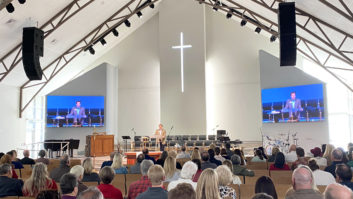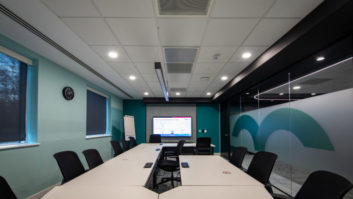
In the first part we considered the benefits of traditionally broadcast-focused manufacturers moving into the AV industry, here David Davies looks closely at the corporate sector and the impact of greater convergence.
Asked whether the primary driver behind video solution development for the corporate market is the ability to offer users the greatest possible flexibility of inputs, Crestron technology director Stijn Ooms responds emphatically: “Spot on. In the corporate sector you might have businesses that are using VGA or HDMI, and there are still some using DVI. Then there are some who are now primarily using IP. So ideally you want the ability to mix and match all the signals on the same platform that you have coming into the facility.”
In the corporate market, in particular, Ooms stresses the continued popularity of HDBaseT – the uncompressed AV connectivity standard whose 2.0 specification, issued in mid-2013, heralded a number of enhancements that further increased its appeal to pro-AV users. “Pretty much any boardroom, presentation room, videoconferencing [installation you might identify] over the last five years makes use of HDBaseT technology,” he says.
For Crestron, its presence in the corporate market continues to be focused around its DigitalMedia product family. Designed to enable the management and distribution of digital AV and control signals, DigitalMedia delivers besides fully uncompressed video over copper and fibre, and also low-bandwidth network AV with or without a matrix switcher, using standard 1Gb Ethernet infrastructure and devices. The range includes extenders, switchers, transmitters, receivers, distribution amplifiers and various accessories.
Classy connectivity
The ability for multiple sources both inside and beyond a workplace to be managed and brought together has been a particular boom area for manufacturers active in this space. This is something to which KVM (keyboard, video, mouse) specialist Adder Technology can attest, with recent product launches including the AdderLink XDIP – which can extend video, USB2.0 and audio along a single minimum spec of Cat5e cable for 100m, and further by routing through existing infrastructure.
Adder’s technology strategic sales manager EMEA, Jamie Adkin, says that in “the broadcast market we have been looking at the challenges for customers wishing to manage multiple servers, or who have disparate users positioned around a business and require KVM to access those machines at critical points in the process. On the other hand, in the corporate AV market, we find customers who are maybe looking more at distributing video and maybe touching signage, and therefore wish to extend signals like VGA or HDMI into a permanent installation.”
More generally, it is to be expected that – as in so many other sectors – discussion around technology for the corporate market now revolves around the transition towards IP-based operation. But there is no doubt that we are in a period of transition as organisations determine how exactly they should bring multiple systems onto a single unified IT network – and, critically, ensure that all the necessary security precautions are put in place.
Luke Mahler-Hausen, AV and live business development, EMEA, Blackmagic Design observes that “we are in a period of uncertainty; everyone knows a move to an IP video backbone has to happen, because it will greatly increase flexibility within installations and allow organisations to use their IT networks for AV. As yet, no one is entirely clear about the best way to proceed. For now, that means users are putting in place temporary infrastructure with the expectation that things will change within the next two years. What we know right now is that customers want a low-cost HD solution that is easy to use and allows them to retain full control over their systems. It will be a very interesting area of development, particularly in corporate installs.”
James Keen, marketing manager at Tripleplay agrees that convergence is coming, but with very specific expectations: “Any kind of technology has to be secure in order to be adopted by any enterprise, not just secure in that the streams can’t be viewed, but secure in that the systems that manage them can’t be hacked. Enterprises don’t want to operate a network for their IT systems and then a completely separate network for their video streaming and broadcast technologies; they appreciate the value of convergence and expect their suppliers to understand that. From this perspective, the technologies we deliver tend to have to be integrated with [secure authentication protocols] SAML, LDAP and Active Directory, as well as delivering video encryption security. Enterprises also see their streaming and broadcast technology as a mission-critical system and so failover and redundancy is expected too; something Tripleplay offers, which many others cannot. There is also a growing demand for these solutions to be delivered over virtualised networks, to thin clients – a very difficult thing to achieve.”
www.adder.com
www.blackmagicdesign.com
www.crestron.eu
www.tripleplay-services.com







